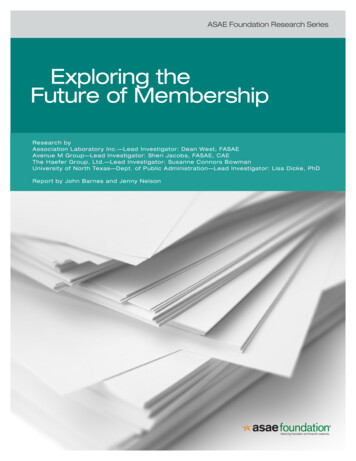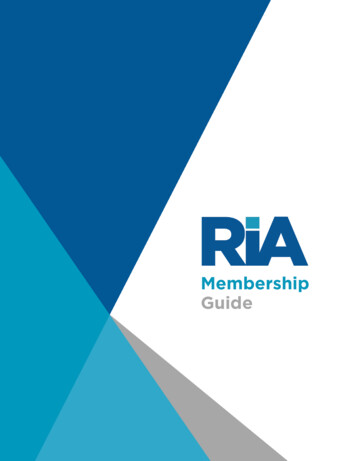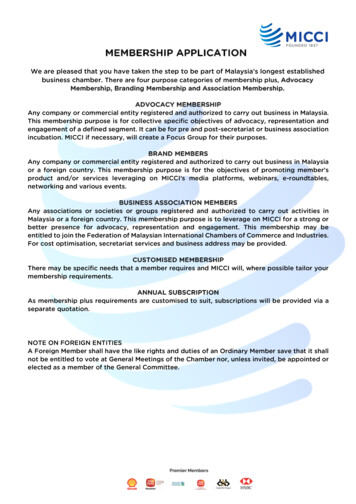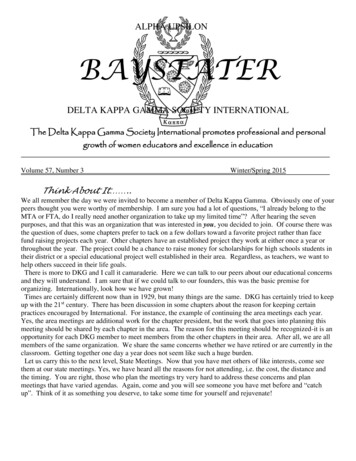
Transcription
ASAE Foundation Research SeriesExploring theFuture of MembershipResearch byAssociation Laboratory Inc.—Lead Investigator: Dean West, FASAEAvenue M Group—Lead Investigator: Sheri Jacobs, FASAE, CAEThe Haefer Group, Ltd.—Lead Investigator: Susanne Connors BowmanUniversity of North Texas—Dept. of Public Administration—Lead Investigator: Lisa Dicke, PhDReport by John Barnes and Jenny Nelson
Special thanks to:Exploring the Future of Membership Research Grant RecipientsAssociation Laboratory Inc.—Lead Investigator: Dean West, FASAEAvenue M Group—Lead Investigator: Sheri Jacobs, FASAE, CAEThe Haefer Group, Ltd.—Lead Investigator: Susanne Connors BowmanUniversity of North Texas—Dept. of Public Administration—Lead Investigator: Lisa Dicke, PhDExploring the Future of Membership Volunteer Task ForceSharon Kneebone, CAE—Institute of Food TechnologistsToni Rae Salmi—International Foodservice Distributors AssociationAndrea Rutledge, CAE—National Architectural Accrediting BoardRetreat & Report ContributorsChelsea R. Killam—ASAE Foundation2Greg Melia, CAE—ASAE: The Center for Association LeadershipSharon E. Moss, Ph.D., CRA, CAE –ASAE FoundationWorkshop AttendeesLowell M. Aplebaum, CAE—Society for NeuroscienceRhea L. Blanken, FASAE—Results Technology, Inc.Rebecca Brandt, CAE—Executive Director, Inc.Denise R. Brown—American Counseling AssociationTrudie Bruner, MBA, CAE—Fernley & Fernley, Inc.Kathleen A. DeMarco—Stringfellow Management GroupAbe Eshkenazi, CSCP, FACHE, CPA, CAE—APICS The Association for Operations ManagementGregory J. Fine, CAE—Turnaround Management AssociationJames Garnett—Nassau County Dental SocietyEric HampAlison E. Heron—Council for Exceptional ChildrenDJ Johnson, IOM, CAE—Drug Information AssociationMelody Ann Jordan-Carr—ASAE: The Center for Association LeadershipWendy W. Kavanagh, CAE—Georgia Society of Association ExecutivesJulia B. Koch, CAE—Produce Marketing AssociationTony R. LeClerc, CAE—The Harrington CompanyLee K. Lowery, CAEDiana Tavares Mertz, CAE—American Staffing AssociationNatalie Nardone, CMP, CAE—Nardone Consulting Group, Inc.Hester Ndoja, CAE—Florida Society of Association ExecutivesASAE Foundation Research Series Exploring the Future of MembershipCopyright 2014 by ASAE Foundation. All rights reserved.
Arlene A. Pietranton, Ph.D., FASAE, CAE—American Speech-Language-Hearing AssociationSuzanne C. Pine, CAE—Association HeadquartersLaura Poko—Global Cold Chain AllianceSusan R. Robertson, CAE—ASAE: The Center for Association Leadership/ASAE FoundationIlyse Shapiro—Avalon Association ManagementJeanne Sheehy, MBA—BostromMarcellette Sherman, CFRE—North Texas CommissionKeith C. Skillman, CAE—ASAE: The Center for Association LeadershipMelissa Walling, IOM, CAE—Institute of Real Estate ManagementEleanor Warmack, CAE—Florida Recreation & Park Association3ASAE Foundation Research Series Exploring the Future of MembershipCopyright 2014 by ASAE Foundation. All rights reserved.
Table of Contents4Introduction5Membership in context: providing value to members where they are7The impact of other decision-makers: engaging influencersto get new members9Changing roles and responsibilities: the association positionin the larger community11Curation of information and data: a new opportunity for associations13Removing barriers to change: tackling the obstacles that preventassociations from getting better15Conclusion17About the Authors18About the researchers18ASAE Foundation Research Series Exploring the Future of MembershipCopyright 2014 by ASAE Foundation. All rights reserved.
IntroductionThe ease of connection afforded by technological tools could tempt one to call into question the very need for associations. Associations do have a vital role to play in enabling individuals to connect with one another and accessinformation, but, as membership organizations, they must explore new routes of engagement and connection to stayrelevant to their members. It has never been more important or timely for the association community to critically assess how associations, and association membership models, are evolving. To effectively serve their constituencies,and to thrive, associations must consider the future of their membership structures.With this in mind, the ASAE Foundation provided grant funding for an examination of the evolving characteristics ofprofessional affiliation and the economic and societal trends that affect engagement. The outcome of this research isintended to shed light on the critical shifts that are occurring related to association memberships and to provide guidance and direction for future research. This initial phase was exploratory and generated a number of discussion pointsfor critical examination that you are invited to consider within the context of your own organization and the broaderassociation community.5The ASAE Foundation designed the research initiative to investigate the future of association membership in twophases: 1) report generation by recipients of an ASAE Foundation grant, and 2) a collaborative interpretation workshop. The first phase was designed to fuel the conversation, and to that end the Foundation administered a grantopportunity for multidisciplinary research initiatives that examine the future of membership. In designing their research,applicants were asked to address three questions regarding association membership:zWhat are the disruptive innovations in other forms of affiliation that are proving to be viable solutions for peopleseeking to identify with groups and advance their interests?zHow will engagement behaviors of individuals and organizations be impacted in the future by the economic environment?zWhat is the nature of community and what unique roles are “associations of the future” uniquely positioned toserve?In 2013, the ASAE Foundation awarded four grants. The researchers each produced a white paper that summarizedtheir findings related to the above questions. While the researchers were tasked with the same questions in the sametopic area, each group chose a unique approach.zThe Future of Association Engagement presents the research by Association Laboratory. The study includedanalysis of secondary research on association engagement conducted by Association Laboratory, results from Association Laboratory’s 2014 association environmental scan “Looking Forward,” and data collected via discussionswith 33 association chief staff officers and senior membership professionals via online bulletin boards. This studyin particular examined the macro forces and large-scale social changes that affect membership decisions on anorganizational level and an individual level.ASAE Foundation Research Series Exploring the Future of MembershipCopyright 2014 by ASAE Foundation. All rights reserved.
zAvenue M Group produced Innovations in Membership Engagement: A Benchmarking Study by examining 14organizations that have created successful and innovative membership models that both encourage growth andsupport the mission of the organization. In their exchanges with these organizations, Avenue M Group identifiedfive key factors organizations took into account when making successful changes to their membership strategies.zNew Realities Existing Within Converging Trends: The Future Is Now from The Haefer Group, Ltd. and BlankenConsulting/Results Technology, Inc. used in-depth interviews, a literature review, and multiple case studiesto focus on the value proposition of the future for membership organizations. The study relates six “new realities”associations must understand and address to engage their membership: demographic shifts, technology andco-creation, networks, volunteerism and civic engagement, blurred sector boundaries, and recent economic shiftsand the changing labor market. These external realities shift in importance depending on the internal needs of themembers/associations, so it is incumbent on associations to identify how the new realities relate to their situationand find a balance between them.zThe white paper How Can Professional Associations Provide Meaningful Value for Their Members: Creating Models of Affiliation and Engagement, from the Department of Public Administration, University of North Texas(UNT), employed surveys, in-depth interviews, and focus groups to query 12 international doctoral students studying in the United States about their experiences with associations. From these conversations, the study gainedmore information about how these students came to choose their association affiliations, how they engaged, andhow they would like to engage in the future.The full text of the white papers can be found here asaecenter.org/membershipresearch.Once the research reports were completed and submitted, the second phase of the program intended to bring the6conversation to association professionals. The Exploring the Future of Membership Research Retreat was held March7-8, 2014 in Orlando, Florida. The four grant recipient researchers presented their findings to retreat participants, whoincluded chief staff executives, membership professionals, and association management company leaders. Thesepresentations were followed by a series of facilitated discussions to allow participants to consider the informationand ideas presented, to ask critical questions about the findings, and to discuss how the findings affect the range ofmembership issues facing their respective organizations.In discussing the four white papers, the retreat participants extracted five key themes related to the future of association membership. These themes appeared repeatedly in the studies and reflected the participants’ own experiencesand concerns:zMembership in context: providing value to members where they arezThe impact of other decision-makers: engaging influencers to get new memberszChanging roles and responsibilities: the association position in the larger communityzCuration of information and data: a new opportunity for associationszRemoving barriers to change: tackling the obstacles preventing associations from getting betterThe five key themes that emerged from these discussions represent critical shifts in the business of association membership. They represent the point at which the findings of the research reports intersect with the concerns and needsof association leaders, and they offer questions for association executives to consider. These themes are explored ingreater detail in the following report.ASAE Foundation Research Series Exploring the Future of MembershipCopyright 2014 by ASAE Foundation. All rights reserved.
Membership in context: providing valueto members where they areIn a society where people are increasingly capable of seeking out the information and networks they want when theywant it, associations now face the challenge of demonstrating and delivering unique value to their membership. Thebenefits associations offer must address the different needs of their members and provide value to individual membersrelative to where they are in their life journey.Several of the research papers picked up on this growing trend. The Avenue M Group research found that associations were increasingly offering their members routes to connect based on their needs and interests rather than themore-standard professional level or age group categorization. One of the organizations highlighted in Innovations inMembership Engagement, AIGA, the professional association for design, revamped its membership pricing and structure to meet the needs of its members and drive engagement. Instead of a membership model based on the stageof an individual’s career, AIGA’s membership pricing and benefits reflect the member’s interest in and commitment toinvolvement with the association.7Another organization, the Indiana University Alumni Association (IUAA), increased membership by creating smaller,targeted events designed to bring together individuals around a common interest. This allowed IUAA to forge strongerbonds with individuals who are most likely to engage while offering them appealing networking activities.This theme of “meeting members where they are” was reiterated in the retreat discussions. Retreat participants notedthat, in the past, associations were better positioned to tell members what was or was not of value for their careers aswell as for their industry. Associations defined value. Today members define value for themselves based on their ownindividual context.The definition of this value shifts for the individual at various points in his or her life as professional or business, andas personal needs grow and evolve. A person might join an association for specific resources and find membershipimmensely rewarding. But if that member’s situation changes and the association offers nothing of value for his orher new situation, why would the member renew his or her membership? Associations are now expected to adaptto meet their members’ needs along their evolving life journeys. This requires providing resources and supports for avariety of situations, rather than providing a one-size-fits-all program of benefits.Associations have the ability to better address this expectation through personalization and segmentation supportedthrough various social media and other rapidly improving communication technologies. Associations can use thedata collected about their members to leverage new opportunities and resources that meet their members’ needs.However, the opportunity to effectively meet individual expectations based on context must be balanced with the understanding that an association can’t be all things to all people. The very notion of providing such individually orientedprograms and services seems to run counter to the collective aspects of associating with a group of people for alarger good.ASAE Foundation Research Series Exploring the Future of MembershipCopyright 2014 by ASAE Foundation. All rights reserved.
“The individual defines the community to meet their needs; this may not bethe same way the association defines the community.”—Retreat participantIn the end, this discussion raised a number of questions to consider when examining the future of association membership. Is it possible for associations to accommodate their membership model to the person that joins for onlyone reason, whatever that may be? And is something lost if the membership model is so different from individual toindividual—is the notion of associating suffering by this individualized approach?While conceding the potential that individually oriented programs and services may undercut the very concept of association, does a keen awareness of the context of individual members lead to new insights as to the needs of the entiremembership of an association? Is this an opportunity moment for associations?With this opportunity comes the challenge of the monetization of membership models targeted toward the uniquecircumstances of individual members. This is an inherently more complicated model which will entail more resources tomanage and will have an impact on the bottom line. Is the return on investment warranted?8ASAE Foundation Research Series Exploring the Future of MembershipCopyright 2014 by ASAE Foundation. All rights reserved.
The impact of other decision-makers:engaging influencers to get new membersToday potential members are not likely to make the decision to join independently. Economic factors and the influenceof family and senior colleagues drive that choice, not infrequently making that choice for the potential members. Thisissue was investigated in several of the research papers, which found numerous points of influence on whether or notan individual joins an association and which association he or she joins.UNT’s How Can Professional Associations Provide Meaningful Value for Their Members: Creating Models of Affiliationand Engagement focused on international students attending graduate school in the United States and found association membership was highly influenced by outside sources. For these students, membership to a related associationwas required by their departments. Students receive guidance on when to join associations and which associations tojoin based on the value perceived and expressed by their professors and mentors, with emphasis placed on the quality of networking opportunities and the profile of the organization’s conferences.9The research presented in The Future of Association Engagement indicates that many membership decisions areteam-based within the context of budget planning, particularly at trade associations. In many instances, individualsare less involved in decisions about which memberships their organizations will support. Individuals increasingly haveto consider the value of membership in terms of the money coming out of their own pockets, at which point at-homeinfluencers have to provide input.Participants at the research retreat expanded on the discussion of the many individuals and groups involved in themembership and engagement decision-making process. In their discussion groups, the participants reflected on theresearch and considered what associations are doing now and could do in the future to influence these influencers togain new members and more fully engage their existing members.Family members weigh in on the time commitment and resource commitment of members, and engaging family members can foster positive feelings for the association community. One professional society is reaching out to the parentsof students in their field by advocating for their child to join the association. By being proactive and pointing out thecareer benefits, this organization was able to tap into the parental desire to see children succeed. Associations withinternational members have begun recognizing the fact that some cultures are more family-centric than others, andthis reality is also being addressed by the association community. Associations must creatively and effectively engagewith families to expand membership and create a positive membership experience.The work environment also offers opportunity for associations to engage with influencers. As UNT’s study observesand retreat participants discussed, faculty at educational institutions have considerable influence on the ability of student and junior faculty members to commit time to associations. There is an opportunity for associations to reach outto faculty and student groups to solidify connections and expand partnerships.ASAE Foundation Research Series Exploring the Future of MembershipCopyright 2014 by ASAE Foundation. All rights reserved.
“In a large member company, we have to make our membership pitchto perhaps ten people and our approach has to be different for each ofthem.”—Retreat participantRetreat participants were concerned about the impact of changing economic conditions and shifts in industry andprofessional structures discussed in Association Laboratory’s research. Employers are weighing in on the specificassociations they want their employees to join, or not join, and they are expressing opinions about employees’ timecommitment to the association and away from their job. Participants concurred with the research that the onus is onassociations to demonstrate their value to employers. Associations will see a return on this investment—in provingtheir worth to these decision-makers, associations are likely to gain members among the employees.The variable nature of the decision-making process will always be a challenge, and retreat participants articulated anumber of questions that associations can consider as they reach out to potential members and their influencers:zHow do we speak to the decision-makers as a larger group, but still recognize the individual who will ultimatelybelong?zIn some settings, a membership campaign may need to be targeted to multiple individuals who determine whetherone individual should become a member of an association. Does this advocacy to the larger group not fully respectthe individual who will become a member of the association?10zIs it possible to establish the idea of community among the decision-making group even if they are not the memberof the association?zEven if the decision-makers are not formally a member of the association, can the association attempt to solveproblems for this group through the membership of the individual?This challenge is different for professional associations and trade associations. In a professional association, memberengagement is measured by individual transactions; in trade associations, the association may only have one primarycontact and the association might struggle with making personal connections with other leaders at the company.The issue is even more complicated for hybrid membership organizations, which must address both individual andorganization engagement. But in all cases—in professional and trade associations—there are new professionals andpotential members emerging every year. Associations can reach them through their influencers.ASAE Foundation Research Series Exploring the Future of MembershipCopyright 2014 by ASAE Foundation. All rights reserved.
“We have to be active in sustaining our role in the larger community. It won’tjust subsist without our work and responsiveness.”—Retreat participantChanging roles and responsibilities: theassociation position in the larger communityAnother theme retreat participants gleaned from the research papers was the notion that associations have a responsibility to their community. “Community” can be defined any number of ways, but whether it implies a geographicconnection or a more abstract network founded on shared concerns, it is clear that today’s professionals want to bemore connected with the world around them. Several of the research papers explored the question about the types ofactivities members want associations to engage in, and what associations can do for their communities.As described in New Realities Existing Within Converging Trends, there is an increase in civic engagement and volunteerism, especially “when the value for such activity is self-evident.” It is not surprising then that, as UNT’s study notes,many association members are also involved with nonprofit volunteering, and these members are especially interestedin volunteering for their association on socially important activities. Association members are driven to engage withtheir communities, local and/or professional, on issues that matter to them.11A case study put together by The Haefer Group/Blanken Consulting/Results Technology highlights the American Association of University Women (AAUW) “supporter” strategy to broaden its membership base. To drive this strategy,AAUW creates petitions regarding issues of interest to its base and potential base. Supporters who sign a petitionreceive AAUW’s Action Alert, a weekly advocacy newsletter, which keeps the supporters in the loop about related issues and AAUW’s advocacy efforts. Supporters also receive low-key messages about membership and donation. Thisstrategy has been a significant success for AAUW, probably in no small part because it allows potential members toget involved with both the association and its civic outreach before committing to full membership.Retreat participants observed that the civic-mindedness of the membership has influenced the scope of associationresponsibility. The fundamental value of associations has been their ability to connect a community of similarly engaged people. But as many people feel their commitment to their community should extend beyond their professionaland networking activities, it is advantageous for associations to create opportunities for civic engagement, and indeed,many members now expect community outreach as part of the role of the association.Participants noted that associations have started to address this through programs that engage association memberswith local issues and activities. These activities include contributing to the local food bank or being an active participant in the local chamber of commerce. Even if it’s not part of an association’s mission to provide assistance to thehomeless, for example, members still like to see their associations involved in the broader community. And association members, already members of a regional, national, or international network, certainly believe that communityboundaries are not defined by geographic proximity. If a natural disaster strikes one area of the country, members fromaround the country may expect that the association will assist members in the strike area in the aftermath of the event.Regardless of the specific activity, association members increasingly expect that their professional community willcontribute to and support their larger community.ASAE Foundation Research Series Exploring the Future of MembershipCopyright 2014 by ASAE Foundation. All rights reserved.
“The opportunity to partner with companies on similar causes could moveus beyond the traditional sponsorship model.”—Retreat participantParticipants concluded that associations must think about the unique and exclusive resources that they offer. Localcommunity organizations, online networks, and the other social groups that savvy members tap into to broaden theirlives offer numerous advantages. But associations do, too. Associations offer benefits, resources, and a specific kindof community that these networks cannot. What other type of organization can connect a large number of peoplewith common professional interests and goals and provide them with the physical and intellectual space to share theirpassions, concerns, and ideas? At a time when people spend so many of their waking hours in their workplace, whatother type of organization can help turn a job into a career and a profession into a community? It is important that associations never stop communicating these advantages.However, associations are not the only organizations expanding their members’ understanding of community. Privatecompanies are bringing people together in ways that have traditionally been the role of associations and steppingforward to help their communities unrelated to their profit-driven activities. Associations may be losing their reputationas the sole outlet for industry “do-gooders” as for-profit companies seek opportunities to make a positive impact in theworld beyond the provision of their product.12The lines are blurring between private companies and associations and what they do and provide. The opportunityfor associations then is to partner with private companies and perhaps achieve an even greater impact. New RealitiesExisting Within Converging Trends declares “the blurring of sector boundaries is creating opportunities for business,government, nonprofit collaborations to demonstrate innovation, share learning, and provide mission driven services.”The paper highlights a number of partnerships between private companies and nonprofits that created higher profileprojects to advance the nonprofits’ missions where they align with the private company’s goals. For example, anagreement between the National Science Resources Center (now the Smithsonian Science Education Center) andHewlett Packard was forged in order to improve science education, a goal for both organizations. Partnerships created around a common cause turned the blurring of sector boundaries into an achievement for both sides.For retreat participants, the value in these partnerships was clear. Associations can offer private companies exposureto the people, industries, and professions with whom they want to associate as they seek to fulfill this new role, whileprivate companies may have more resources to support philanthropic activities. It is up to associations to think creatively about the partnerships they can forge to advance their goals.ASAE Foundation Research Series Exploring the Future of MembershipCopyright 2014 by ASAE Foundation. All rights reserved.
Curation of information and data:a new opportunity for associationsFor a long time, associations were relatively unique as the provider of essential and topical information to their constituents. But today information comes from multiple sources, and association members are savvy in seeking out newvenues for content. Associations are now looked upon as only one source of information. But while members may findnew sources, they might not always know what is the best, most useful, or most relevant information. Indeed, this isalready a concern for most association executives. The Future of Association Engagement notes, “An overwhelmingmajority of association executives believe their members are experiencing difficulty managing the volume of information. This is true regardless of the type, size, or geographic scope of the association.” Association Laboratory foundthe development of relevant content, customization of content for distinct audiences, and the delivery of this contentwere a top concerns for association leaders, and to deliver this content in a way that meets members’ needs is crucialto a successful engagement strategy.Indeed, UNT’s study indicated that respondents received information from their associations related to their career and13profession, but frequently their primary sources for information were department colleagues and mentors. The opening for associations, retreat participants concluded, is to be the entity that helps to make sense of the overwhelming amount of information targeted to their members. Furthermore, associations can play a role in helping membersdetermine the most important and most relevant information for their needs. Even members within the same industryor career field may have different interests based on their individual context. The prioritization of information for theindividual that is accessible and specific to that person’s life journey may be a growing role for a
James Garnett—Nassau County Dental Society Eric Hamp Alison E. Heron—Council for Exceptional Children DJ Johnson, IOM, CAE—Drug Information Association Melody Ann Jordan-Carr—ASAE: The Center for Association Leadership Wendy W. Kavanagh, CAE—Georgia Society of Association Executives Julia B. Koch, CAE—Produce Marketing Association











